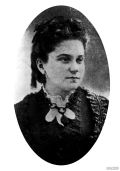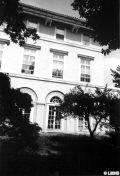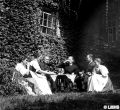



| <-- Previous | LMHS Home | Contents | Order Book | Next --> |
The historic sport of cricket has been a part of Lower Merion since it was first played at Haverford College in 1834. In 1865, fifteen young Main Line enthusiasts first played cricket on the grounds of Colonel Owen Jones’ estate in Wynnewood; next on new club property acquired on Cricket Avenue in Ardmore.
Since the move to Haverford in 1892, Merion Cricket Club has a long history of involvement with other sports: lawn tennis (1879); bowling (1895); golf (1895), the cricket and golf clubs separated in 1942; soccer (1896); squash racquets (1900); field hockey (c. 1900); badminton (1937). For many years, the club has hosted important tournaments in these various sports and an impressive group of its members have become national champions.
Merion Cricket, after 134 years, continues to support a vital progarm of family-oriented athletic and social programs within its fine facilities in Haverford: fine sportsmanship, good fellowship.

The space was soon inadequate for the club’s number and enthusiasm, and they built a new clubhouse, in 1891, on Cricket Avenue in Ardmore. A destructive fire damaged it the next year.

When Merion Cricket moved out of their Ardmore location after the fire, the property was purchased by Hamilton & Yarnall in 1892. Despite the fire, they enclosed the porches and established St. Mary’s Laundry.

The driving force behind this ambitious project was Emily Borie, Mrs. James Rhodes who, with her husband, organized the laundry to give work to the women of St. Mary’s Parish who were devastated during the hard times that followed the national panic of 1893.

"The Cricket House", along Montgomery Avenue, was connected and had showers and locker facilities and sat beside a stable and shed structure. Another era ended again when the massive "Main House" was completely destroyed by fire in January 1896. Valuable documents were also lost— the original founders’ papers of October 1865 along with valuable club pictures, trophies, and other relics.

The 1896 fire of "The Main House" was a total loss. Only the chimneys and some bearing walls remained. But work was immediately begun on a larger house, a substantial brick and terra-cotta structure that was set back toward Grays Lane, designed by the prestigious Philadelphia architects, Furness and Evans. The new site provided a much larger field for both cricket and tennis.
There is a description of the new clubhouse in Hotchkin’s 1897 book, Rural Pennsylvania..."porte-cochère and recessed porches, two separate hallways for men and women— a large central hall for general use, and on one side the café, library, and billiard-room for men, and on the other the ladies reception and tea-rooms. Below stairs are bowling-alleys and shuffle-board rooms, store-rooms, ladies’ tennis-rooms, cricket dining-room, lavatories, etc. The second floor contains a large main dining room, private dining-rooms, bed-rooms for men, bath-rooms, etc., and a large theatre with dressing-rooms and a separate entrance. On the third floor are more bed-rooms for men, kitchens, sewing-rooms and rooms for employees. The whole house is heated by one large boiler, and lighted with both gas and electric lights. It is supposed to be the most complete and largest country-club house in this country."

Incredibly, in the fall of 1896, tragedy struck once again!. Local papers deemed the September blaze of mysterious origin. At a $150,000 loss, they reported that the fire could have been caused by "rats gnawing at matches." The photo shows the bucket brigade, who bravely (and elegantly) fought the blaze at four in the morning . Thanks to a good water supply and the dedication of local volunteers, a large part of the building was saved. Once again, the stalwart directors of the club acted decisively and the clubhouse was restored within half a year.

The Indian Olympic Field Hockey Team vs. the U.S. Olympic Team, August 1932, at the Merion Cricket Club. A club member recalls: "We played them on the front field before four or five thousand people. It was one of the most colorful sights with the Indians in their turbans and their ability to play the game." The Indians handed terrible defeats to the U.S. team...24-1 at the Olympics and 17-2 at Merion.
Haverford College took to cricket from the beginning. It was introduced there in the 1830s by William Carville, an English gardener brought over to landscape the new campus. In 1834, the first cricket club, made up entirely of American youth, began one year after the college opened. Haverford’s Quaker founders weren’t sure about the effect the game’s excitement would have on students who were encouraged to study and behave with fitting decorum. But even the staid members of the Society of Friends recognized cricket’s historical appeal: the game has been traced as far back as the Middle Ages. Creagh was one of its early forms, played around 1299. In the colonies, prior to 1776, cricket was known as a "gentleman’s game."
A mile-long oval race track for harness racing was created in 1876 on land where Washington and his troops, after crossing the Schuylkill, had camped on September 13, 1777 on a site called Price’s Field.
Built during the Centennial in Philadelphia, the track was on 72 acres along Meeting House Lane, just down the road from Merion Meeting. Horse racing was a popular sport since Colonial times, so these sulky races drew many sportsmen, racers, and spectators. Droves of tourists came by carriage from the city and filled local inns, rooming houses, and the General Wayne.
Favorite horses like Star Pointer, the Guideless Wonder, Jay Eye See, May Queen and Maude S. Smuggler were featured stars. For the Grand Circuit of 1917, racers and trotters came by train from stables in New Hampshire, Kentucky, Ohio, and Massachusetts, arriving at the Cynwyd rail station. A half-mile track, within the original oval, was added in 1890.
At one time there were 300 members of the Belmont Driving Club. Joshua Evans, the president for many years, was succeeded by the second (and final) one, Frank Bower. But interest in sulky racing began to decline, and even races of automobiles and motorcycles no longer attracted many crowds.
In the fall of 1924, the entire acreage was sold to a construction company for $300,000 (a 200% profit for the stockholders).
With plans for 374 lots, paved streets and sidewalks, and a number of fine homes, Merion Park became a substantial residential community where, ironically, many of its homeowners never heard of the exciting sulky races of the past.

The clubhouse was an elaborate three story building with wide verandas and a second floor porch. Ladies with their escorts sipped claret lemonade, and the men cheered the sulky races from porches below and the nearby grandstands.

Sign at the Montgomery Avenue and Meeting House Lane corner pointed the way to the track: "Belmont Driving Park. Licensed. Open to the Public. Draft Beer," (perhaps to the chagrin of some members of Merion Meeting).

Divided Belmont Driving Park Clubhouse #1. In the mid-1920s, after the track was razed, the Belmont Driving Park Clubhouse was divided and moved within what was now Merion Park; both parts remain today as private homes.
It was in 1900 that the Overbrook Golf Club was incorporated and the golf course built on some 93 acres of land leased from the owners of the Greenhill Farms Plantation. There were still great trees and green hills as well as a flowing stream at the site. Originally deeded by William Penn to Thomas Lloyd in 1682, the tract had increased to over 300 acres by 1714. Wistar Morris, whose mother had inherited the property in 1799, spent his life on the property. His stone mansion built in 1863, is now owned by Friends’ Central School.
The golf club remained on the site until 1948, when it was sold for $500,000 to developers. Then the club moved west to Sproul Road where it intersects Godfrey Road in Villanova. On its former site we now find Lankenau Hospital.
Philadelphia and its Main Line, including the social and athletic movers and shakers, enjoyed to the full the advantages of the countryside—its trails, roads and rivers—from the late 1700s on. The invention of the cycle, the high-wheeler, gave another risky pleasure, followed by the bicycle which gave safer riding and greatly increased the number of cyclists.
The two oldest clubs, the Germantown Club and the Philadelphia Field and Cycle Club, were born in 1879. The site of the Philadelphia Club was on the corner of Church Road and Lancaster Pike in Ardmore.
Early in this century, the cyclists had rehabbed a summer residence at that location called Green Gables.

The von Trapps with the family priest, Father Franze Wasner, at left, who also conducted the twelve singing Barons and Baronesses.
The Maria von Trapp life story, immortalized by the 1959 Rogers & Hammerstein musical The Sound of Music, had a lively Merion chapter. Baron Georg von Trapp, Baroness Maria, their two sons and seven daughters (ages 7 to 27) arrived in 1938 at 252 Merion Road virtually penniless. As singers seeking refuge in America after fleeing the Nazi takeover of Austria, they settled in that comfortable house lent by Merion lawyer and music patron Henry S. Drinker, Jr., an authority on Bach. There the family’s tenth and last child Johannes (who became the clan’s chiarismatic leader) was born in 1939.
While there, the family also learned to become self sustaining and regained its financial stability, which enabled it to buy the Vermont farm where it moved fulltime in the mid 1940s (and still owns).
The von Trapps already had a jump-start in turning their singing hobby into a successful profession in Europe. Over here, singing soon became a way of life for them. Yet from baking to house-cleaning, like the Swiss family Robinson, they did every chore, made all their own clothes, shoes, furniture, pottery.
At Merion, the distinctive Tyrolean garb of dirndls and lederhosen they all wore daily for reasons of thrift, soon became a Trapp Family Singers signature. One of the concert field’s most heavily booked attractions, they performed as a group for 25 years.
The 1965 film of The Sound of Music won the Academy Award for best picture of the year and was for several years the all-time top money earner, even beating out Gone With the Wind. And an estimated 600,000 people worldwide still see The Sound of Music each year.

Regularly, at four in the afternoon, the adult von Trapps gathered for the traditional Austrian coffee hour in Merion.
| <-- Previous | LMHS Home | Contents | Order Book | Next --> |